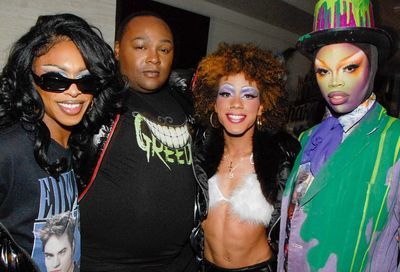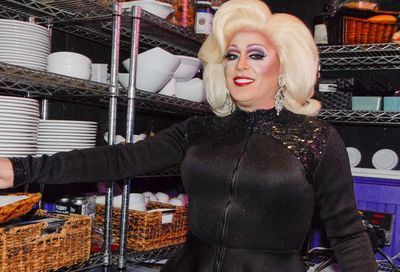Halfway There
Folger's 'A Midsummer Night's Dream' is mainly solid, but creaks under some ill-chosen staging devices
William Shakespeare’s A Midsummer Night’s Dream is a perennial favorite, containing everything needed for a fun night of theater: a broad range of characters, an impish spirit and a happy ending.
Therefore, staging an original production that will entice an audience is always going to be on the forefront of a director’s mind. For the Folger Theatre’s production, director Joe Banno has set Shakespeare’s comedy in the 1930s, with sporadic musical numbers scattered throughout. Well, lip-synching numbers, actually.
 |
When it comes to these numbers, too much of a good thing can be, well, too much.
As with many of Shakespeare’s plays, the line between comedy and tragedy is quite thin. The outcome of Midsummer could easily have been a tragedy on par with Romeo & Juliet. Hermia (Briel Banks) is in love with Lysander (Marcus Kyd), though she is betrothed to Demetrius (Tim Getman). When told they cannot be together, the two lovers flee, while being pursued by Demetrius and his stalker, the plain Helena (Stephanie Burden). Once the lovers run into the woods, they enter a dreamlike world and become pawns in the feud between fairy king Oberon (John Lescault) and his queen Titania (Deborah Hazlett).
Without question, the sprite Puck (Kate Eastwood Norris) is always a coveted role. Flitting around the stage as a childish imp who toys and plays with love, Puck’s final ”If we shadows have offended” soliloquy is an audition favorite in high schools all across the country. In any production of Midsummer, the treatment of Puck is inevitably a large measure of the play.
To round out the cast, a group of ill-trained ”actors” perform the play’s final scene, a tribute to theater that’s meant to be painful. This group provides an Upstairs, Downstairs/Gosford Park look into the 1930s world that Banno has devised. As the cast upstairs is clad in fine period clothing, downstairs the help is poorly dressed and rudely behaved. Lead by Bottom (David Marks), the ragtag group provides an additional level of levity to the comedy.
The concept of setting Midsummer in the 1930s is slow to come to fruition. It is not until the initial musical number that the plan fully starts to crystallize. A lingerie-clad Puck performs the first song, lip-syncing about dreaming your troubles away. It’s cute and sets the stage for the fairy-land dream sequence, but the device is quickly overused.
Norris is strong as Puck, turning a role often associated with an immature boy into a sexy, flirty ingénue. Norris runs around the stage in various combinations of Victoria’s Secret attire — always maintaining some element of leopard print on her body. Her relationship with Oberon is more like an elaborate seduction than servitude.
As Oberon, Lescault initially appears to fall into the trap of being a whiney brat as he screams and throws a tantrum during his fight with Titania. However, despite his love of swishing his silk robe behind him, Lescault’s performance is reined in and saved. Hazlett does a fine job of slinking across the stage in her silver nightgown and doting on the donkey-headed Bottom while under a love spell.
As the four lovers running through the woods, Burden’s Helena is the stand out, throwing herself into the part and taking Helena’s obsession with Demetrius to the edge. It’s just this side of utterly pathetic. Burden finds the comedic balance and carries the weight of these scenes.
| A MIDSUMMER NIGHT’S DREAM To Nov. 26 Folger Theatre 201 E. Capitol St. SE. $25-$50 202-544-4600 www.folger.edu |
Getman and Kyd also deliver solid performances as men under a spell, and Banks makes a strong Folger debut as Hermia.
Erhard Rom’s simple staging uses classic Art Deco designs to set the time period, while the dream-sequence requires little more than a large mattress and dangling moon. Kate Turner-Walker’s costumes are both fun and elegant. Whether it’s the silk sleepwear for the dream-sequences, or period clothing for the ”real world,” the actors are well-dressed for their parts.
Banno relies on some cheap laughs to sustain the play’s pace. In fact, physical comedy dominates the second half, overshadowing Shakespeare’s words as the actors have a full-fledged cat fight on stage — men and women alike. Unfortunately, like the final musical numbers, by this point of the play, you just wish it would stop.
By the time Bottom and his troupe of hopeless actors take the imaginary stage to perform for their audience, the real audience is also wishing for a speedy resolution. Their intentionally painful production is just that — painful. When Puck returns to deliver the final lines, it’s a relief to again enjoy Norris’s performance.
Support Metro Weekly’s Journalism
These are challenging times for news organizations. And yet it’s crucial we stay active and provide vital resources and information to both our local readers and the world. So won’t you please take a moment and consider supporting Metro Weekly with a membership? For as little as $5 a month, you can help ensure Metro Weekly magazine and MetroWeekly.com remain free, viable resources as we provide the best, most diverse, culturally-resonant LGBTQ coverage in both the D.C. region and around the world. Memberships come with exclusive perks and discounts, your own personal digital delivery of each week’s magazine (and an archive), access to our Member's Lounge when it launches this fall, and exclusive members-only items like Metro Weekly Membership Mugs and Tote Bags! Check out all our membership levels here and please join us today!




















